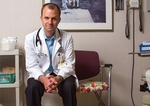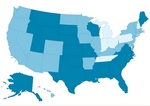health
Physicians key in tackling the nation’s obesity epidemic
■ If drastic steps are not taken, 42% of the U.S. population could be obese and 11% of the overall population by 2030, a study shows.
- WITH THIS STORY:
- » How doctors can help overweight patients
- » External links
With obesity rates expected to surge during the next two decades, the Institute of Medicine is calling on physicians to become more involved in preventing overweight and obesity in their patients and communities.
In a report issued May 8, the IOM recommended that physicians regularly assess patients’ body mass index; ask patients how much physical activity they get each week; and offer overweight and obese individuals behavioral interventions aimed at improving their physical activity and diet.
Data show that although many physicians are aware of such recommendations, some doctors still are not identifying patients who are obese and taking the proper steps to help them achieve a healthy weight, according to the IOM report.
Contributing to the problem is insufficient time during patient visits for overweight screening, limited payment for counseling patients on ways to improve their lifestyles and inadequate resources, such as nutrition specialists, the IOM said.
The report included recommendations that medical schools educate students on how to incorporate BMI screening and effective discussions on behavioral interventions into patient visits. And it urged physicians to advocate in their communities and states for policies that will improve physical activity and nutrition resources for their patients.
“Physicians are key players in [preventing obesity],” said Sandra G. Hassink, MD, a member of the 16-person IOM committee. “They help families understand the problems that accompany obesity and what to do about it.” Dr. Hassink also is director of Nemours Pediatric Obesity Initiative at Alfred I. duPont Hospital for Children in Wilmington, Del.
The report stresses that effectively preventing obesity will take more than the involvement of physicians. “Obesity is both an individual and societal concern, and it will take action from all of us — individuals, communities and the nation as a whole — to achieve a healthier society,” said IOM President Harvey V. Fineberg, MD, PhD.
The report was released at the three-day Weight of the Nation conference May 7-9 in Washington. The conference was hosted by the Centers for Disease Control and Prevention and aimed to highlight what is being done to prevent and control obesity through policy and environmental strategies.
In developing its recommendations, IOM committee members evaluated hundreds of strategies related to obesity prevention and identified five goals that should focus the nation’s efforts in improving the public’s health:
- Make physical activity an integral and routine part of life.
- Create food and beverage environments that ensure healthy food and beverage options are the routine, easy choice.
- Transform messages about physical activity and nutrition.
- Expand the roles of health care providers, insurers and employers.
- Make schools a national focal point.
Projections show rising numbers
A third of adults are obese, as are 17% of children and adolescents, according to the CDC. The prevalence of obesity in that age group has nearly tripled from 1980, when about 6% of youths were obese, the CDC said.
As a result, a growing number of Americans, including youths, are developing chronic conditions related to excess weight, some of which are fatal. Those conditions include diabetes, hypertension and cardiovascular disease.
The estimated annual cost of obesity-related illnesses is $190.2 billion, according to the IOM.
If drastic steps are not taken, 42% of the U.S. population could be obese by 2030. Eleven percent of the overall population could be severely obese, according to a study published in the May 7 issue of the American Journal of Preventive Medicine.
In 2010, 5% of people were severely obese, the study said.
The findings were released during the Weight of the Nation conference.
“This is just another reminder that we’re still not quite there yet [in terms of efficient obesity prevention], and we still need to think creatively about how to change individual and societal behavior,” said Justin G. Trogdon, PhD, co-author of the May 7 journal article. Trogdon is a research economist at RTI International in North Carolina. RTI is a nonprofit institute that provides research, development and technical services to government and commercial clients.












